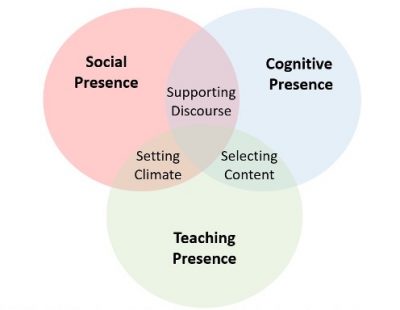By Tracy Hodgson-Drysdale, MEd, PhD, Educational Technology Development Coordinator at Teaching and Learning Services, and Instructor at Carleton University, University of Ottawa, Boston College and Lesley University
If you have ever wondered whether it’s an oxymoron to ask if we can be present in our online classrooms, or whether the terms “present” and “asynchronous” are mutually exclusive, I’m happy to say the answer is “No!” to both. It’s possible to be present and build community in online courses, providing students with a better learning experience, while also increasing our own satisfaction with a job well done. If you are wondering how to accomplish this in your own classroom then read on, for it happens in more ways than one, each with its specific benefits.
There are three interrelated types of presence instructors can control in online learning: social, cognitive and teacher. They work together to form a framework called a Community of Inquiry (CoI) model, which promotes social interaction and constructivist approaches to learning (Garrison, et al., 2000).
- Social presence is how we, as instructors, build community in our online classes by creating opportunities for different types of interactions. These can occur between students and the instructor, but they can also involve interactions between students, and even student interactions with course content. Social presence can also provide an opportunity for us to model the social skills students will need in their careers.
- Cognitive presence is how we, as instructors, create opportunities for students to engage in critical thinking and meaning making. This presence is what helps students modify their thinking along a continuum, from learning new information, to integrating it with prior knowledge and applying it to solve a problem.
- Teacher presence refers to how we use course design, facilitation and instruction to create engaging online courses, and it brings together social and cognitive presence in online classrooms.
Elements of an Educational Experience
Here are some tips to help you incorporate the CoI model into your courses to help create an engaging environment.
Social presence: Show that you are a real person!
- Use announcements in your course to dispel the myth that you are a robot.
- Include a welcome announcement to connect with students from the start of the course and to set the tone for building a community of learners.
- Schedule weekly announcements to provide updates and reminders:
- Make students aware of what is important each week
- Provide updates on how the class is doing with assignments
- Remind students about upcoming deadlines
- Alert them to current events that are relevant to the content of the course.
- Limit the number of announcements that appear on your homepage, while still having them all available to students in the announcement tool. This means that students can go back and check them for important information throughout the course.
Cognitive presence: Get students thinking more deeply
- Provide space for metacognition and reflection on learning through journals or group debrief discussions.
- Challenge students to synthesize their knowledge and experience with the new content through assignments that relate to real world problems and solutions, such as creating action plans to promote positive change.
Teacher presence: Use social and cognitive presence to help students meet objectives
- Design your course with a simple layout. Name your modules with a week, module or unit number and a brief connection to content.
- Participate in discussions. Referring to what students posted, quoting a section of a post, showing appreciation, etc. all show engagement
- Set clear expectations in the syllabus. Something as simple as letting students know when you will reply to emails will help them have reasonable expectations (i.e., “I will reply to emails during regular business hours (9:00am-5:00pm EST) Monday to Friday and mornings (8:00-10:00am EST) on weekends”).
Next steps
Now that you know it’s possible to be present in an asynchronous course, it’s time to get started! Pick one of the suggestions above and try it. Prove to yourself that asynchronous classrooms can be engaging spaces where you build a community with your students and give them a better learning experience. If you’re feeling really adventurous and you want to know what students think of your online presence, you can survey them to find out. Chances are you will also increase your own satisfaction at a job well done!
Have questions about how to create online presence in your course? Request a course consultation and come and meet with TLS. We can help!
For more on this topic, see the blog A Profile Picture is Worth a Thousand Words (to our students!).
